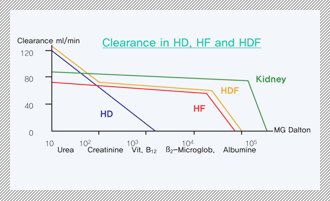01Maintains high proficiency in artificial kidney treatment.
02Provides convenient transportation and a cozy treatment environment.
03Conducts nighttime dialysis (5 PM to 10 PM) for working professionals and students.
04Uses high-flux (high-efficiency) membranes (filters) to reduce complications (e.g., muscle attack disorders).
05Aims for high-flux blood dialysis (using high-flux membranes with high blood flow and dialysate volume), which may shorten the dialysis time, for example, reducing a 4-hour session to 3.5 hours.
What is Hemodiafiltration (HDF)?
Hemodiafiltration (HDF)
Hemodiafiltration is a method that combines conventional hemodialysis and hemofiltration, which is mainly used for emergency dialysis and removal of excess fluid in general hospitals. It offers high removal rates not only for low molecular toxins (Urea, Creatinine) but also for middle molecules (Vitamin B12) and high molecular substances (B-2m), making it the most advanced dialysis method to date.
Key Advantages
Effectively reduces the problem of low blood pressure (hypotension) during dialysis. In long-term (7 to 10 years or more) dialysis, it removes over 80% of B-2m that could accumulate in the body, minimizing complications. It is the most effective method to remove toxins from the body, closely resembling the function of the human kidney.
Patients Who Can Benefit from HDF
Patients who have difficulty with blood pressure regulation during dialysis may face challenges in undergoing dialysis. However, for those who can maintain residual kidney function and experience satisfactory dialysis apart from this issue, it can be a viable option. It is recommended to consult with a specialist for further guidance.




